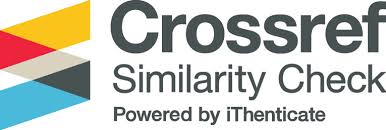Combination of Aleurites mollucana L. and Apium Graveolens L. in Alopecia Disease Model
Abstract
Candlenut oil and celery leaves have been widely used by people in the world as a treatment for hair loss problems as well as strengthening hair roots and blackening hair. Hair loss disease or in the medical world called alopecia is a disease where the amount of hair loss is more than hair growth in general. The main cause pf alopecia generally occurs due to inflammation in the hair follicles. The purpose of this experimental animals used, namely male rabbits of the New Zealand White type.
The study began by testing the phytochemical screening on each of the materials used. Furthermore, a combination of candlenut oil and celery powder was carried out to form a nanoemulsion preparation. After that, tests were carried out including pH, emulsion type, hair growth including hair weight and thickness of the shaving area.
The results showed that the co,bination of candlenut oil and celery powder had a pH value of 6.30 with an emulsion type, namely oil in water (O/W) and had hair growth activity from test animals for 28 days with the average weight and thickness of hair 0.2458 and 1,15 cm. this result is better than average positive control product X with an average weight and thickness of 0.2076 and 1 cm. in addition, compared with the negative control, the results of weight and hair thickness were 0.0305 and 0.5 cm. based on these results, it was concluded that the combination of candlenut oil and celery powder had good hair growth activity in experimental animals so that it could be used as treatment therapy for alopecia patients.
References
2. Ardhaninggar AAA, Rahmadewi. 2018. Penatalaksanaan Alopecia Areata. Berkala Ilmu Kesehatan Kulit dan Kelamin – Periodical of Dermatology and Venereology. 30(1); 34 - 39.
3. Wang E, McElwee KJ. 2011. KJ. Etiopathogenesis of alopecia areata: why do our patients get it?. Dermatology Therapy. 24; 337-47
4. Li Y, Yan B, Wang H, Li H, Li Q, Zhao D. 2015. Hair regrowth in alopecia areata patients following stem cell educator therapy. BMC Med. 13; 87.
5. Gilhar A, Etzioni A, Paus R. 2012. Alopecia areata. N Engl J Med. 366(16): 1515-25
6. Tharumanathan S. 2015. Understanding the biological mechanism of alopecia areata. Am J Dermatol Ven. 4(1); 1-4.
7. Hardianti. 2021. Pemanfaatan Tumbuhan sebagai Obat Tradisional oleh Masyarakat di Desa Sumillan Kecamatan Alla’ Kabupaten Enrekang. Skripsi. Makassar. Fakultas Pertanian Universitas Muhammadiyah Makassar
8. Mustarichie R, hasanah AN, Gozali D, Saptarini NM. 2018. Pemanfaatan Herbal Rumahan untuk Obat Anti Kebotakan di Desa Karangsari, Kecamatan Karangpawitan, Kabupaten Garut, Jawa Barat. Jurnal Pengabdian Kepada Masyarakat. 2(6); 1-4
9. Arlene A. 2013. Ekstraksi Kemiri dengan Metode Soxhlet dan karakterisasi Minyak Kemiri. Jurnal Teknik Kimia USU. 2(2); 6-10.
10. Kuncari ES, Iskandarsyah, Praptiwi. 2015. Uji Iritasi dan Aktivitas Pertumbuhan Rambut Tikus Putih: Efek Sediaan Gel Apigenin dan Perasan Herba Seledri (Apium graveolens L.). Media Litbangkes. 25(1); 15-22.
11. Nurjanah N. Krisnawati M. 2014. Pengaruh Hair Tonic Lidah Mertua (Sanseviera trifasciata Prain) dan Seledri (Apium graveolens Linn) untuk Mengurangi Rambut Rontok. Journal of Beauty and Beauty Health Education. 3; 1-8.
12. Vivek PC. (2019). Nanotherapeutics and Nanobiotechnology In: Shyam S. M, Shivendu R., Nandita, D., Raghvendra, K. M., Sabu, T. (ed.) Micro and Nano Technologies, Applications of Targeted Nano Drugs and Delivery Systems; 1-13. Amsterdam: Elsevier.
13. Lina NWM. Maharani T, Sutharini MR, Wijayanti NPAD, Astuti KW. 2017. Karakterisasi Mikroemulsi Ekstrak Kulit Buah Manggis (Garcinia mangostona L.). Jurnal Farmasi Udayana; 6; 6-10.
14. Suryono C., Ningrum L., Dewi TR. 2018. Uji Kesukaan dan Organoleptik Terhadap 5 kemasan dan Produk Kepulauan Seribu Secara Deskriptif. Jurnal pariwisata. 5 (2); 95-106













